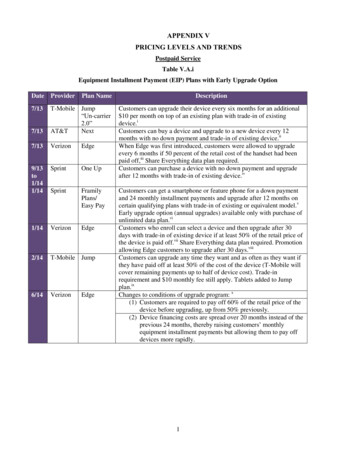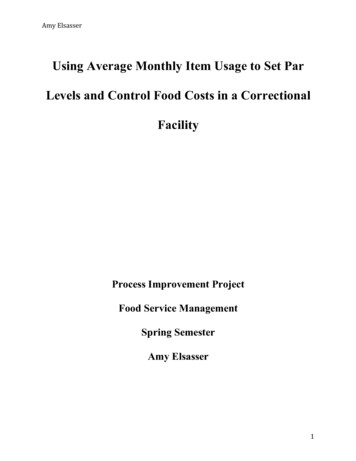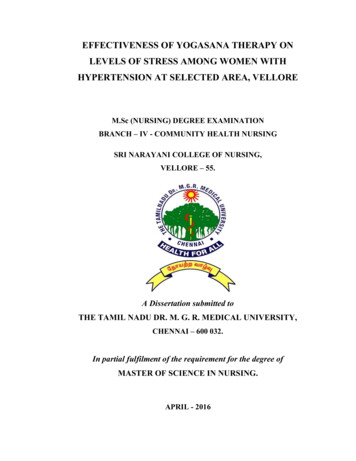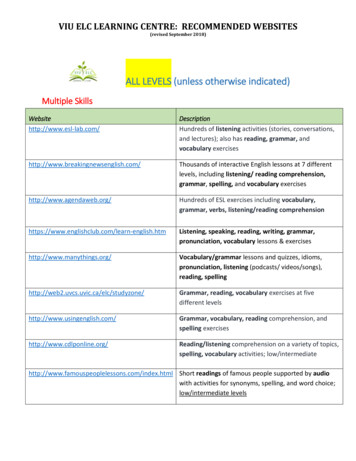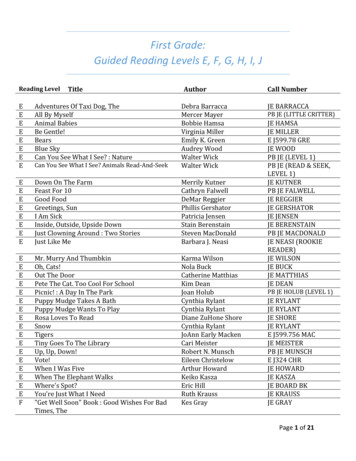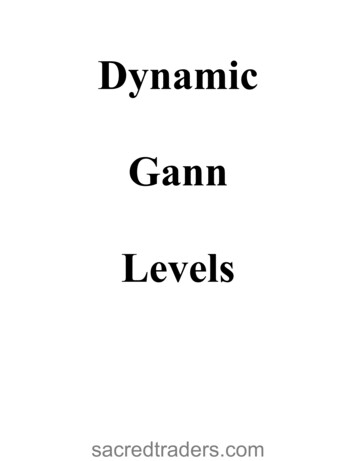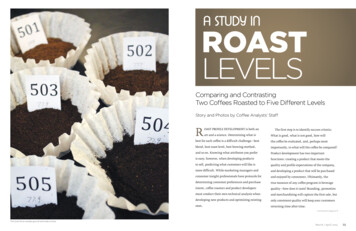
Transcription
ANALELE UNIVERSITĂłII“EFTIMIE MURGU” REŞIłAANUL XX, NR. 2, 2013, ISSN 1453 - 7397Ana GheorgheComparison Criteria and Performance Levels forSoundproofing Panels Made in Different Constructive VariantsThis paper presents an analysis of the performance lavels andcomparison criteria for panels made from different soundproofingmaterials, in different constructive variants. Setting the performancelevel, on the basis of normative and regulatory documents, forsoundproofing materials contained inside of noise reduction devices, isdetermined so that it can be defined, tested and established feasibletechnical solutions for sound absorbing protection, through adissemination of obtained results as well for ensuring requirements forimplementing the technology transfer for manufacturing.Keywords: soundproofing materials, noise reduction devices, performance levels1. IntroductionNoise reduction devices (soundproofing barriers) are designed to reducenoise levels existing or predicted in sensitive areas at this parameter, located inclose proximity of buildings or built spaces (factories, warehouses, etc.). what isconstituted in harmful sources of noise pollution, as well as those which arelocated close proximity to important communication paths (highways, roads withintense traffic), having a high level of road traffic. Under these conditions fromconceptual point of view, noise reduction devices can be defined as an obstacleplaced between the noise source road traffic) and receiver (built spaces, highways,the population located in close proximity of communication paths) which modifiesthe sound wave propagation and which by reflection, refraction and absorptionreducing sound levels, as shown in the following figure:63
Figure 1. Transmission of sound waves in presence of noise barrier, [1]As we can see in the figure above, a part from wave is reflected by thesoundproofing screen (reflected energy is the energy worn by the waves reflectedby the bounding surfaces of the screen), other part, from wave is absorbed,another part, from wave, is transmitted through the screen by receiver(transmitted energy represents a fraction of the energy emitted by a certain sourceand and transmitted beyond of its bounding elements) and the last part, fromwave, is diffracted. For avoid the disrupting of some neighborhood by the reflectedwave, figure. 2 (a) it should be directed beyond the area that must by protected,figure 2 (b). For diminish the reflected wave it can act through the application ofsound absorbing materials on the screen surface that is directed towards thesound source, figure 2 (c):b)a)c)Figure 2.64
Taking into account the modalities for diminishing the noise transmitted isdefined sound insulation characteristic and sound absorption characteristic of noisereduction devices, such as, [2]: Impossibility for a part of acoustic energy crossing the certainmaterials, similar to other materials that are poorly conductive by heatand power represents the sound insulation capacity of a material. Thisability is determined by the mass of material, being limited by certainmechanical characteristics which, for some frequencies, have as a resulta transparency for sound, causing resonance effects. The ability of a material to convert acoustical energy into thermalenergy (vibrations), reflecting a minimal part, represent soundabsorption characteristic of the material. Based on experiments carriedout by researchers in the field, it was noted that in areas built withtraditional materials like marble, brick or glass, which do not possess ahigh soundproofing capacity, is observed the echo phenomenon , duethe reflection of sound waves, resulting a overall increase of noise levelwith serious consequences for the occupants of those spaces. In soundprotected spaces it can highlight a sensation of sound acoustic comfort.Sound insulation and sound absorbing screens are used for protectionagainst noise made by stationary sources (stadiums, schools, markets - forensuring the acoustic comfort) and also can be mounted at the edge of a street,can be installed as a screen in industrial areas with noisy technologies (example:separation of parts of a hall with noisy equipment from another part with quieterequipment), on traffic roadways (mounted on the edge of national roads,highways, railways, in airports), with double role: sound insulation - for receptorslocated on the opposite side from the source (on the edge of traffic roadways) andsound absorption - for receptors situated on the same side as the source (vehiclesin traffic).2. Sound absorption capacityCharacteristics of sound waves propagation have a decisive role in theprocesses of distribution, attenuation or amplification of sound energy.At the propagation of sound waves through a medium, in addition to thephenomenon of attenuation appears and the phenomenon of absorption. Soundabsorption defines the way in which composition surfaces of enclosed areasbehaves in relation to the incident sound waves. The sound waves lose graduallyof their energy, this turning it into heat. The sound absorption is highly dependenton his frequency, the higher sounds (higher ν) are more strongly absorbed thanthose low. This phenomenon is because the energy emitted by the source isdistributed on spherical surfaces with increasing rays, such as energy intensity per65
unit area decreases with the square of the radius of the sphere, respectively thedistance between source and receiver.3. Soundproofing materialsKnowledge of absorbing material, and their structure, is essential for noisecontrol. The main feature that defines absorbing materials is their porousstructure, pores communicating with each other through channels or openings ofthe material. Because of the viscosity of air, both between the particles of air, andbetween them and the pore walls occur friction forces which irreversiblytransformed into heat energy a part from acoustic energy of waves, [8]. Thermalconductivity of air helps dissipate at acoustic energy waves which crossing soundabsorbing material. Along with the air are put in motion fibres of material, theysuffer bending movements. Internal friction of the fibers of material, that occurdue their deformations, lead to increasing sound absorption material, [8].Acoustical absorption of sound absorbing materials is in close contact with anumber of physical characteristics, of which the most important are the porosityand resistance to air flow through them.4. Experimental results for constructive variants subjected totestsIn order to study the ability of noise absorption for noise reduction deviceplaced on the road traffic, we are subjected to test two types of absorbingelements as follows:- first variant – acoustic element made from concrete coated with wood fiberbonded with cement, with dimensions L 5 m; l 0,5 m; H 0,22 m (fromwhich 9 cm represent wall thicknes of the absorbent made from wood fiberbonded with cement (5 cm thicknes of wood fiber cement bonded and 4 cmthicknes of mineral wool, and 12,5 cm represent thicknes of layer concrete);- second variant – acoustic element made from two sheets of aluminum alloy,thickness of sheet of aluminum alloy 1,2 mm, with insertion of mineral woollayer, thicknes of mineral wool 5 cm, with dimensions L 4 m; l 0,5 m; H 0,115 m. Front element (side facing the source of acoustic noise) has aperforation with holes with ø10 mm at a distance of 8-14 mm. Sheets ofaluminum alloy, perforated, are mounted alternatively with unperforated sheets,2 by 2, layers of mineral wool are mounted inside of the formed pannel towardthe perfored side.Were performed tests for determining the sound absorption coefficient atnormal incidence in conformity with the requirements from reference standard SREN ISO 10534-2:2002, [4]. Sound absorption is characterized by "sound absorptioncoefficient, α” defined as the ratio of the total amount of transmitted energy andtotal energy absorbed and total energy incidence of sound waves. Absorption66
coefficients are used to evaluate the effectiveness of a material to absorb thesound. Sound absorption coefficient is expressed on standardized frequencies or byclasses of absorption and is calculated using the equation, [4]:α Ei Er Ea Er EiEi(1)Sound absorption coefficient will be 0% if all the energy of sound waves isreflected at the impact with a surface. If energy is absorbed or passed on, soundabsorption coefficient will be 100%. The values are usually provided in thespecialty literature at standard frequency by 125, 250, 500, 1000 şi 2000 Hz, [4].Sound absorption phenomenon may occur, in generally, for any of thefollowing cases: porosity (seen in materials with a fibrous structure such as woodbased products), cavity resonance (seen at noise barriers perforated or slotted) ormembranes (membranes can be made of rubber, plastic sheets, fabrics, etc.anddepending on the material used for filling Structure can give the same absorptionproperties as in the case of the cavity resonance).Sound insulation, also called transmission loss, is the ability to prevent thetransmission of sound energy because a part of the acoustic energy is "hindered"to cross certain materials, similar with other conductive materials that are poorheat and electricity. This ability is determined, in general, by material mass m[kg/m2] and sound frequency f [Hz], being limited by certain mechanicalcharacteristics which, for certain frequencies, resulting in a "transparent" forsound, causing resonance effects.For acoustic element made from concrete coated with wood fiber bondedwith cement measurements were performed on two samples of acoustic elementwith different thicknesses of 25 mm and 46 mm, and for acoustic element madefrom aluminum alloy and mineral wool, measurements were performed on asample taken from it, diameter of the sample were 63,5 mm. The samples weremounted in the impedance tube without air gap, and the method used fordetermination is the method of stationary waves, or determinations method withKundt tubul.The results obtained for determining the sound absorption coefficient, α,are presented below:67
Figure 3. Variation of sound absorption coefficient depending on frequencyfor variants of acoustic elements consideredNote: The values of the absorption coefficient shown in earlier pro tables are determinedbased on method of transfer function - FFT analysis.For acoustic element made from concrete coated with wood fiber bondedwith cement can be observed that for sample with 25 mm thickness, the soundabsorption coefficient has the values increasing until the frequency of 2500 Hz,point in which reaches the maximum value of 0,708, after which it values startsdecreasing. For sample with 46 mm thickness, it can be observed that has thevalues increasing until the frequency of 1250 Hz, point in which reaches themaximum value of 0,724, after which it values starts decreasing forming a curveuntil the frequency of 2500 Hz, after which the values start to rise again. Analyzingthe graphs of sound absorption coefficients for the two samples of materialconsidered can be observed that they have high values and covers the wholerange of frequencies considered.For acoustic element made from aluminum alloy and mineral wool can beobserved can notice that it has much higher values for the entire range offrequencies considered in comparison with acoustic elements made of concretecoated with wood fiber bonded with cement. Maximum value of 1,12 for soundabsorption coefficient is achieved at frequency of 400 Hz compared with acousticelements made of concrete, with 25 mm thickness, at which maximum value of0,708 for coefficient is achieved at frequency of 2500 Hz, and for sample with 46mm thickness maximum value of 0,724 for coefficient is achieved at frequency of1250 Hz.For determining the air noise isolation index tests were performed inconformity with the requirements from reference standards SR EN 17931,2,3:1999, [3, 5, 6] and SR EN ISO 10140-2:2011, [7]. According Cap. 5 and Cap.5.1 from reference standard SR EN 1793-2:1999, [5] (SR EN ISO 10140-2:2011,[7]) air noise isolation defines the action through which seeks as separatorselements between two media must reducing airborne sound transmission between68
spaces on which separate them. Noise reduction shall be effective in bothdirections of transmission noise. In this case it is useful to consider one room asthe source room (emission) and one room as the reception room (reception).Measurements were made between two rooms, one emission room in which wasgenerate white noise and a reception room where is measured the response oftested materials to subjected at noise emitted, after it has crossed the samples ofmaterial under tested. Both rooms have the same size, as 4100x3200x2900,(Lxlxh, mm), and the volume is 38 m3. The size of the test sample is 10 m2.According to reference standard SR EN 1793-2:1999, index "R" for air noiseinsulation is calculated by the formula:R L1 L2 10 lgS[dB]A(2)where:L1, L2 represents noise levels in emission and reception spaces, [dB];S represents sample surface, m2;A represents equivalent absorption area, in reception room, m2, calculatedby the formula:A 0,161 VT(3)where:V is the volume of reception room, expresses in m3;T is reverberation time, expressed in s.Unique index of evaluation DLR is an suitable element, in particular, tocharacterize the air sound insulation in situations where the incident soundreceived by screen, comes directly from the flow of traffic without havingundergone on surfaces reflections or has been diffracted on the edges of anti-noisescreens or barriers, [3].Unique index of evaluation for performance of air sound insulation DLR, indB, is calculated by the formula, [5]:18DLR 10 lg 1 100 ,1Li 10 0,1Rii 1(4)18 100 ,1 Lii 1where:Ri is the sound reduction index in the frequency band "i" to 1/3 octave;69
Li is standardized sound pressure level, weighted A, normalised, for
EN ISO 10534-2:2002, [4]. Sound absorption is characterized by "sound absorption coefficient, α” defined as the ratio of the total amount of transmitted energy and total energy absorbed and total energy incidence of sound waves. Absorption . 67 coefficients are used to evaluate the effectiveness of a material to absorb the sound. Sound absorption coefficient is expressed on standardized .
